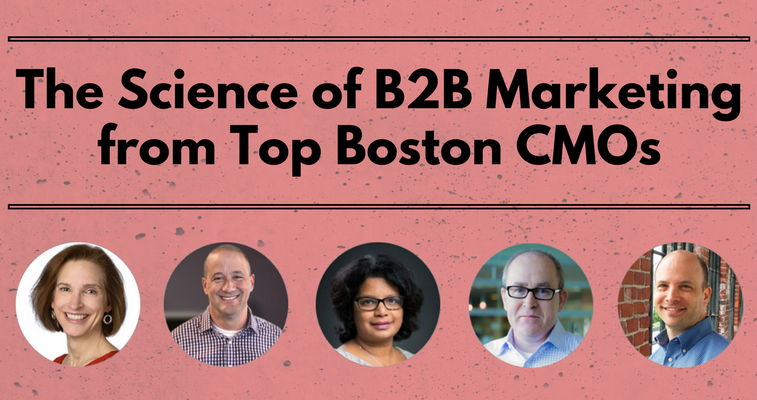I spend a lot of time talking to companies of all shapes and sizes. Helping them figure out how to fix what’s broken, find new opportunities and, ultimately, accelerate results.
The call usually comes from the CEO and there are a myriad of reasons why they contact me. Sales are down, leads are weak, the pipeline is lackluster, the story isn’t resonating, the brand lost its mojo, and/or competitors are swarming. When I get to the marketing function, sometimes there’s a CMO; sometimes not. Some have a shiny new intern who is supposed to make it rain; some have 50+ people and a gangster budget and still can’t make it rain. In all cases, they have one thing in common: as the marketing firepower, they are expected to deliver highly qualified leads that result in revenue producing sales. Stat.
No pressure, right?
In today’s world of “marketing as a science,” marketers must:
- Keep up with the pace of new platforms, tools and technology
- Own the pipeline, lead flow and lead quality
- Tell the story in an effective, compelling way
- Test and try new things to grow leads and sales
- Demonstrate results through robust metrics and reporting
- Make it consistently rain revenue
It got me thinking about how to share what I know with other marketers to help them excel in their careers. I set off to talk to a handful of the top B2B CMOs in Boston. I wanted to get their advice, tips and tricks that they’ve learned the hard way so that I could share them with all of you. I’m a sponge for learning new things and meeting new people. So, in addition to being experts at B2B marketing, the people on my list were all CMOs I had never met before. Now, I have five new, talented, marketing smarties in my network. FTW.
Here are the CMOs I spoke with:
- Carol Meyers – Rapid7
- Supriya Chaudhury – Clavis Insight
- Andy Zimmerman – Evergage
- Bryan Semple – SmartBear
- Gar Smyth - DataXu
All About the KPIs
I started the conversations with KPIs. They are what every C-Suite and Board want to hear, discuss and track. They are the make it or break it of most CMOs, and the numbers don’t lie.

I started my KPI conversations by talking to Andy Zimmerman at Evergage to find out what they measure. He told me there are “Hundreds of rows of data that they are constantly looking at.”
However, it all boils down into three key metrics and strict definitions for each:
- AQL (Automated Qualified Lead): At Evergage, AQLs are defined as an “engaged” lead, meaning they track responses (aka someone raising their hand and clicking through or doing something that connotes interest) and translate those into unique respondents (often the same person has 2+ responses). They research each AQL against a variety of criteria, including the person’s job role as per LinkedIn and their company size, industry, location and website traffic, to decide if the respondent is a workable lead. Those who pass the test are contacted by BDRs and go into a nurture stream.
- MQL (Marketing Qualified Lead): Once a workable lead is pursued by a BDR, the next stage is to turn it into an MQL and set an appointment. There is a very high bar for becoming an MQL and a tight definition for the leads that make it to this stage. In my opinion, I see companies often push too many leads into MQLs, causing sales to churn and waste time and effort. Set clear and tight criteria for this stage. Make sure the lead is worthy. Quality trumps quantity.
- SQL (Sales Qualified Lead): At this stage, sales is actively working the lead. Marketing is getting information on how the meetings are going, what’s resonating and not and where there are gaps to close the deal. Andy talked a lot about the relationship between sales & marketing and how it is key to the success of the business. A tight lead flow and qualification process plus high quality content is a winning formula when it comes to making that relationship sing.
Carol Meyers at Rapid7 had some interesting insights on KPIs beyond the lead flow.

“The most important metrics we track help us assess how effectively we are acquiring, retaining and increasing value of and for customers,” Meyers said. “For us, it’s not just about whether we are winning customers and growing market share – it’s about measuring the value we are bringing to our customers by measuring adoption, usage, retention and advocacy.”
She filled me in on the approach to measurement at Rapid7.
“We have a central team that builds our dashboards, conducts analysis and ensures data quality. This is beneficial as it means that Sales, Marketing, Products and Finance are all looking at the same data and analysis and there is one source of truth,” she adds. “We use cloud analytics with Domo to make our KPIs and analysis accessible to everyone, eliminating the need to send around reports and giving us the ability to monitor KPIs in real-time.”
Gar Smyth at DataXu has a different approach to metrics and said there are two key data points they track:

- Influenced Revenue on Key Accounts – or how well they are doing supporting the sales team in generating existing and new pipeline in large key accounts
- New Customer Revenue from Marketing Sources – where they can track opportunities back to a marketing interaction that led to an opportunity being created.
I talked with Bryan Semple at SmartBear about measurement and he literally wrote the book on it. If you want the skinny on how to measure your digital marketing efforts, you need to read his book for all the details.

He told me, at SmartBear, their goal and numbers look at initial traffic through retention and renewals. They look at least 100 numbers per market on a trailing 2 week basis. They use a shared Excel sheet, Sharepoint and Google docs and review all the metrics for two hours every other Monday during an online marketing team meeting. Then, he pulls out the key metrics to send up to the C-suite and Board.
Take a look at your KPIs. Are they digging deep enough to drive better marketing decisions?
Top Tools of the Trade
Of course the science of marketing would not be complete without an insanely huge number of tools. You’re busy running your business. How are you supposed to have time to figure out which tools are the best? Have no fear, we’re going to break it down and tell you what the pros are using to run their marketing businesses.
Gar Smyth at DataXu told me, “We are always on the lookout for one of two types of tools:
- Tools that give us insights that we don’t have today – Datahug, for insights into sales activities against accounts and contacts, and Engagio, for insights into all marketing activities at the account level, are two such tools that we have deployed in the last six months for our demand gen efforts.
- Tools that automate a process, that allows us to free up some time and manage a process better – like Allocadia for budget management. We are also looking at RFP/RFI automation tools”

Supriya Chaudhury at Clavis Insight said they use Google Analytics, Marketo, Curata and Meltwater. The first two tools help them connect to lead sourcing and attribution; the second two monetize the value of content.
Smyth also shared some detailed insights about the tools they use and why:
-
Marketo & Salesforce – As the core infrastructure.
-
Datahug – Connects email and meeting activity in Outlook into Salesforce with a server-to-server connection rather than desktop plugins. This allows them to see which accounts and contacts are being interacted with by sales, so marketing can be more precise in nurturing and the account development team can be more precise in targeting certain accounts.
-
Engagio – Account-based marketing tool that allows them to see every interaction with an account – interactions with digital advertising, anonymous traffic on their website, engagements at events, email activity, downloads, etc – and roll it all up to a single view of their target account. They can then layer intelligence over that to inform their demand generation efforts and empower the account development team.
-
DataXu – They use their own advertising automation platform to do account-based advertising. Given a list of accounts, they are able to target video and display advertising to all digital devices connected to those accounts, and report back on an account-by-account basis.
-
Curata – They use it to listen to news on different themes and topics and turn those insights into content.
-
Allocadia – Budgeting is the thankless job in marketing and Allocadia makes it a breeze. Collaborative budget management tool that is super easy to use.
Some other useful tools from the group (some of which were new to me, so I’m looking forward to learning more):
- Sales & Marketing Automation: Salesforce, HubSpot, Pardot
- SEO: SEO Moz, BrightEdge
- Optimization: Google Analytics, Optimizely, Bounce Exchange, Funnel Wise
- Video: Wistia, Vidyard
- Webcasts: On24
- Community and Advocacy: Influitive, Jive
- Social: SproutSocial, Hootsuite
- Measurement & Dashboards: InsightSquared, Domo, Allocadia, Sharepoint
- Content Optimization: Curata, Meltwater
- Demand Gen: Datahug, Engagio
- Personalization: Evergage
And, for some advice about picking the right tools, Meyers had some great questions to ask as you make your decisions:
- What’s the goal of implementing the technology and how will you measure success?
- Will it integrate with the other solutions you are using? How easily and will you be able to maintain tracking across the systems?
- Do the vendors have customers of your size and scale? Caveat – if you want to be on the cutting edge, you may be willing to take some risks on scalability and reliability.
- If it touches your customers or will be mission critical, verify reliability with references and a technology review.
- Try it! We generally require every software vendor to allow us to pilot the software and run a proof of concept. If they are unwilling, we will usually move on to another vendor.
- Fully understand the ongoing “care and feeding” of the solution. Make sure it’s something you can support with your planned staffing.
- Test the security! Make sure whatever vendor you select meets your security requirements.
- Work with your IT and security teams. They have expertise in evaluating technology and can help you more successfully select and implement new technologies.
Smyth’s advice on picking tools:
- Know how your choice of tool will impact your resources. Most tools will require at least half of someone’s time in order to maintain it.
- Look beyond email automation. The explosion of email automation results in customers and prospects getting email fatigue, and you need to look for new ways to engage and increase awareness.
Tools are supposed to help, not suck you into the vortex of drudgery and all-consuming number crunching. Be diligent about your choices. Make sure the tools you pick can be supported by your team, while delivering valuable insights to help you measure success.
Is ABM the new Inbound?
ABM (Account-Based Marketing) is all the rage. If you ask five people what it means, you’ll likely get five different answers. I spend a lot of time with my clients helping them optimize their ABM strategies and, newsflash, there is no one-size-fits-all solution.
I asked the group about ABM and how it’s replacing or changing the inbound marketing strategy and what marketers need to think about in this evolving new ABM world.
“Inbound marketing was a revolution in B2B, and got marketers thinking beyond email, but it was too broad-based to solve for businesses with a set of targeted accounts,” Smyth said about the growing world of ABM. “Marketers now have the tools to find and engage their target audiences with precision dreamed of just a few years ago.
Zimmerman at Evergage had some interesting learnings to share, given their product is designed to help marketers personalize experiences for targeted accounts and individuals.
“We have been doing ABM for a long time. Inbound was all the rage and it was all about content and lots of leads. But, there was a backlash from sales saying, “It’s all crap!” Now we have a different mindset,” he said. “We deliver highly targeted, personalized conversations and experiences. We develop target account criteria (industry, size, geography, etc.) and then go after accounts that fit that criteria.”
Zimmerman adds, “One-size-fits-all website experiences don’t work. We must continue the personalized, targeted conversation.”
Meyers talked to me about ABM and how internal communications and alignment are key. “I think the most important thing to delivering success is alignment,” She said. “Aligning with Sales on the goals and targets, aligning the message and offers to the audience, aligning with sales on next steps and follow up. It’s important to understand how ABM will fit with and complement your other marketing and sales initiatives.”
Finally, Smyth told me, “What works when it comes to ABM is having great data. If your marketing is built on a foundation of bad data, your segmentation, messaging and reach will all be compromised. And, using great tools - Engagio, Datahug, Marketo and DataXu work great for us. But not everything works. We tried manual methods – they don’t scale and learnings are slower. Invest in data, automation and analytics.”
Parting Words: Advice from the Pros
Now it’s time for you to take all of this marketing science forward. Here’s some great advice from the talented CMOs I talked to, and think about how to incorporate it as you look to refine your Marketing efforts to grow your business.
Advice from Chaudhury: “All aspects of marketing link to each other: demand gen, event attendance, social, organic, digital. It’s really important to clearly understand how things are linked and make sure you can track and report the impact.”
Semple told me about the innovative and unique way they are organized. Because of their highly diverse product lines, they decided to decentralize marketing and push it all out into the product lines. His advice is, “Hire people with the potential to be full-stack marketers. Empower them to make decisions. You need to feel comfortable with very distributed decision-making and giving people full accountability.”
Meyers’ advice is, “First, understand your end-to-end funnel and focus your efforts to optimize across the funnel. Don’t focus on volume or just one conversion metric, such as MQL to SQL – it can be easy to manipulate one conversion step and, as a result, negatively impact the total funnel. Second, test, test, test. Try new things. Make sure you able to measure statistically relevant results. And, most importantly, have fun with it!”
“Test and learn,” Smyth says. “When drug companies want to understand what is working, they run statistical clinical trials. Scientists employ design of experiments to make sure they are maximizing their ability to learn from their tests. Manufacturers use Six Sigma and Kaizen to improve their products. The best marketers test and learn. Average marketers rinse and repeat. We have all spent budget on CPL campaigns over and over – ever ask a sales rep how those leads converted? They didn’t. Every campaign is an opportunity to learn. Tactics need to be varied and tested. Email, SEM, advertising, social, inbound, events, tradeshows, wherever you invest, make sure you have a learning agenda.”
Zimmerman at Evergage says,“Stay in sync with your CEO and Head of Sales. Marketers must be 100% clear and in-step with the overall company objectives and build programs that align to the goals of the company. Constant communication is key. Know your numbers. Track as much as you can and share it. Be open to feedback and build great relationships.”
Thanks to Carol Meyers, Andy Zimmerman, Gar Smyth, Supriya Chaudhury and Bryan Semple for sharing their awesomeness.
Go forth and rock your Marketing mastery!
Michelle Heath is Founder & CEO at Growth Street Marketing. Follow Michelle on Twitter: @michelleheath.

